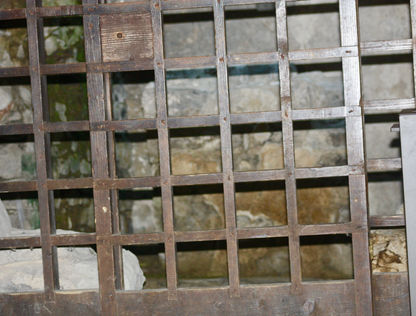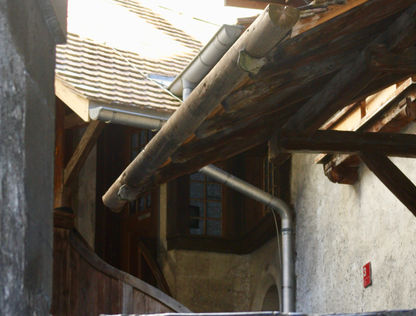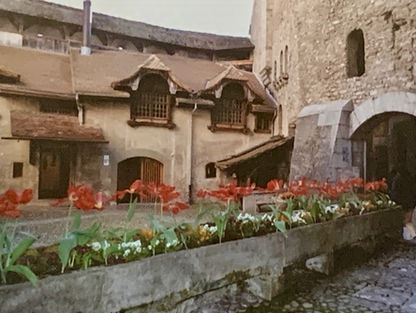
Montreux

SWITZERLAND Diary : Day 6 - 10 April 2014
The Swiss Town of Montreux lies on the eastern coast of the crescent shaped Lake Geneva , covering a small area on the South-Western part of Switzerland. It is also considered a health resort of the Lake. The sun kissed slopes of this region, make it suitable for growing extensive vineyards. The Lavaux vineyards are listed as a UNESCO heritage site. The town is said to have existed since Bronze Age. It is, surprisingly, the French-speaking part of the country. The oldest Hockey club and its Jazz festival are the highlights of this town.
It was our second half of the day 6 in Switzerland. We took a train from Gruyeres to reach Montreux, through Bulle. It was a long journey. Our idea was to cover those regions in the country at least by train. Another train from Bulle reached us to the Montreux station. A Shuttle bus thereafter, got us to the Castle gates. A beautifully groomed garden lead us to the entrance of the Castle. Our Swiss Pass ensured us a free entry. We were welcomed by the towering structure, standing right on top of the Lake Geneva, offering beautiful views of both the Lake and its surrounding Alps.
Positioned on the Ovoid Islet of Chillon (meaning 'a rocky platform') , this 1000 year old Castle is the most visited Historic building of the country. It is stamped as a "Heritage Site" by UNESCO. The Counts of Savoy established their control over this castle for nearly 400 years, due to its strategic position in facilitating trade, on the route running from Italy in the South, to Germany/ France in the North. In a few years the building turned into a DUNGEON, whilst many other castles around the region were utilised purely as SUMMER HOUSES. Later, it did turn into a summer residence for a short while, before being restored and renovated, to gain its current appearance. The castle boasts of being the only one in the country that never underwent a Siege.

With 50 and odd chambers that are opened to visitors, the structure has etched its name as a top tourist spot. We climbed up and down a few stairs to reach the entrance. As we passed through the high arched, corridors engulfed by the thick stone walls, we came across an area loaded with huge oak barrels. There were a total of 40 such casks, stacked on one side. These were filled with wine to serve the in house soldiers. A unique tree at the central quadrangle of the castle caught our attention. Millions of colourful wishes seemed chained to it. The Castle was also maintained aesthetically, without any loss of its "ancient" sheen. We were happy come across a display of the 'castle miniature' which covered its entire layout clearly.
Lord Byron, an 18th century poet, brought the building to spotlight , through his poem PRISONER OF CHILLON, where he described the life of a monk from Geneva, who was imprisoned in one of the dungeons of the castle for about 4 years.
We spotted a stone with Lord Byron's signature on the Castle wall. The layout of the entire castle was split into many floors, dragging us up and down, while on the tour. With several secret passages and door, we had plenty to explore. The stories of deep down cellars that were once used as a kitchen, turning into dungeons, was nerve chilling. Many salvaged kitchen utensils and a part of the kitchen itself, were maintained intact. The rust on the iron gates narrated their own story. A noose hanging from the ceiling in one of the small chambers, reproduced stories of supposed executions. The dungeons, cutting deep into the very rock that formed the base of the castle, were dark, cold and terrifying.
We passed through the main hall of the royal residential area. The designs on the pillars and the mosaic, tiled flooring were proof enough of the rich lives that the Counts led here. A few of the antique furniture that were displayed, still looked polished and robust.
We also came across a 'punishment' chamber. Grasping a 1000 year history in just two hours, seemed impossible. We reached the top floor. The display of armoury here impressed us. There were several kinds of weapons, with varied usage. One of the chambers had its floor area filled with metal armours & weapons. The maintenance of these 'priceless assets' is commendable. A small spiral stairway led to the pinnacle of the fortress from here. The roofing at the top was low. The place was often used for secret viewing. A few specially designed armours and weapons, probably used by soldiers of a higher rank, were seen here. We made our way downwards. A large viewing gallery with huge arched windows lay wide opened, capturing the gracious Lake in a mountainous backdrop, in one of the chambers.
In another, we found a solid wooden pandal installed, with big holes bored in it. We could spot the rocky banks of the lake through these holes. These were the erstwhile toilets. The baths were palatial too. The murals and designs on the walls and pillars captured the true sense of art and craftsmanship that existed. The two hour tour, climbing up and down, discovering the dark secrets and doors along with precious stories, brought about a sense contentment within each of us. With little time left to return to Interlaken, we left the castle to board the shuttle bus. We reached the Montreux station and took a train to reach Interlaken West via Visp. The journey lasted a little more than 2 hours. This was end of day 6 in Switzerland.



























































































